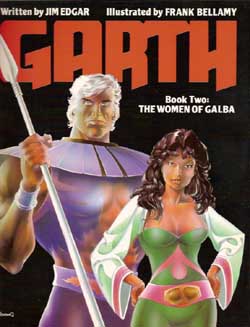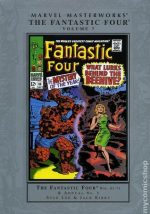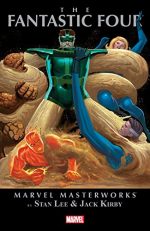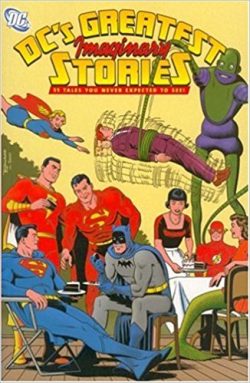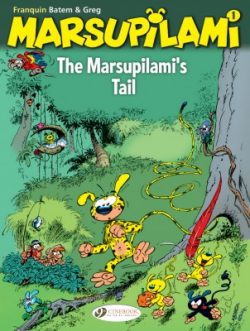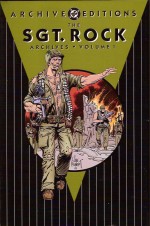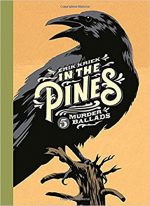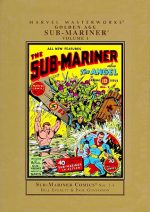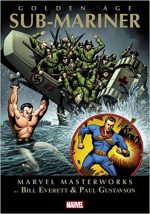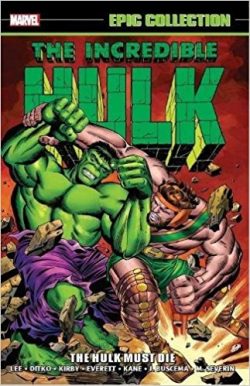
By Stan Lee, Gary Friedrich, Steve Ditko, Jack Kirby, John Romita, Bill Everett, Gil Kane, Bob Powell, John Buscema, Mike Esposito, Jerry Grandenetti, Marie Severin, Herb Trimpe & various (Marvel)
ISBN: 978-1-3029-0445-6
Bruce Banner was a military scientist who was caught in a gamma bomb blast. As a result of ongoing mutation, stress and other factors can cause him to transform into a giant green monster of unstoppable strength and fury.
After an initially troubled few years the gamma-irradiated gargantuan finally found his size 700 feet and a format that worked, becoming one of young Marvel’s most popular features. After his first solo-title folded, The Hulk shambled around the slowly-coalescing Marvel Universe as guest star and/or villain du jour until a new home was found for him and this trade paperback (and eBook) volume covers his years as co-star of Tales to Astonish; specifically issues #60-96, spanning October 1964 to October 1967, and even includes a silly spoof yarn from Not Brand Echh #3.
Way back then, the trigger for the Hulk’s second chance was a reprinting of his origin in the giant collection Marvel Tales Annual #1 (the beginning of the company’s inspired policy of keeping early tales in circulation and which did so much to make fervent fans out of casual latecomers). Thanks to reader response, Ol’ Greenskin was awarded a back-up strip in a failing title…
Giant-Man was the star turn in Tales to Astonish, but by mid-1964 the strip was visibly floundering. In issue #59 the Master of Many Sizes was used to introduce his forthcoming co-star in a colossal punch-up, setting the scene for the next issue wherein the Green Goliath’s own feature began.
‘The Incredible Hulk’ (TtA #60) opens with Banner still working for General Thaddeus “Thunderbolt†Ross, despite the military martinet’s deep disgust and distrust of the puny milksop who had won his daughter’s heart. Aloof and standoffish, Bruce keeps secret his astounding condition: an affliction which subjects him to uncontrollable transformations into a rampaging, if well-intentioned, engine of destruction.
The 10-page instalments were uncharacteristically set in the Arizona/New Mexico deserts, not New York, and espionage and military themes were the narrative backdrop of these adventures.
Lee scripted, Ditko drew and comics veteran George Roussos – as “George Bell†– provided the ink art. The first episode details how an anonymous spy steals an unstoppable suit of robotic armour built by the radiation-obsessed Banner, and concludes with a shattering battle in the next instalment as the Hulk is ‘Captured at Last!’
Cliffhanger endings such as the exhausted Gamma Giant’s imprisonment by Ross’s military units at the end of the yarn would be instrumental in keeping readers onboard and enthralled. Next chapter ‘Enter… the Chameleon!’ has plenty of action and suspense as the spy infiltrates Ross’ command, but the real punch is the final panel, hinting at the mastermind behind all the spying and skulduggery. The enigmatic Leader would become the Hulk’s ultimate and antithetical nemesis…
The minor Spider-Man villain works well as a returning foe; his disguise abilities an obvious threat in a series based on a weapons scientist working for the US military during the Cold War. Even the Leader himself has dubious connections to the sinister Soviets – when he isn’t trying to conquer the world for himself.
Preceded by a titanic Jack Kirby Marvel Masterwork Pin-up of the Green Goliath, ‘A Titan Rides the Train!’ (Astonish #63, January 1965) provides an origin for the super-intellectual menace whilst setting up a fresh subplot wherein new cast addition Major Glen Talbot begins to suspect Banner of being a traitor. The action comes when the Leader tries to steal Banner’s new anti-H-bomb device from a moving freight locomotive….
‘The Horde of Humanoids!’ features the return of guilt-stricken former sidekick Rick Jones who uses his Avengers connections to obtain a pardon for the incarcerated Banner just by letting the American President in on the secret of the Hulk! Ah, simpler times!
Free again, Banner joins Talbot on a remote island to test his hotly sought-after atomic device only to be attacked by the Leader’s artificial warriors – providing a fine example of Ditko’s unique manner of staging a super-tussle.
The chaotic clash continues into the next issue when Ayers assumes the inking and Banner is taken prisoner by those darn Commies. ‘On the Rampage against the Reds!’ sees the Hulk go ballistic behind the Iron Curtain: a satisfyingly gratuitous crusade that spans three issues with #66 – ‘The Power of Doctor Banner’, inked by Vince Colletta and ‘Where Strides the Behemoth’ in #67, (inked by Frank Giacoia), cumulatively exhibiting the brute’s shattering might.
His Commie-Busting fury finally expended, the Hulk reverts to human form and is captured by Mongolian bandits who see a chance to make lots of ransom money…
Jack Kirby returned as illustrator – supplemented by Mike (“Mickey Demeoâ€) Esposito – in Tales to Astonish #68. ‘Back from the Dead!’ sees plucky Glen Talbot extricate the tragic scientist only to lose him again on the way back to America. Even so, Banner falls again into military custody and is ordered to activate his Atomic Absorbatron for one last test.
Yet again the process is interrupted by the Leader’s attacking Humanoids, but this time the Veridian Villain succeeds and the Hulk is ‘Trapped in the Lair of the Leader!’ …but only until the US Army bursts in…
Issue #70 saw Giant-Man benched and replaced by the Sub-Mariner, making Tales to Astonish a title dedicated to aggressive, savage anti-heroes. Increasingly the Hulk stories reflected this shift, and ‘To Live Again!’ sees the furious Leader launch a 500-foot tall Humanoid against the local US missile base, with the Jade Giant caught in the middle.
Kirby reduced his input to layouts and Esposito handles the lion’s share of the art with #71’s ‘Like a Beast at Bay’: a minor turning point with the Hulk actually joining forces with the Leader whilst ‘Within the Monster Dwells a Man!’ then has Major Talbot getting ever-closer to uncovering Banner’s dark secret.
‘Another World, Another Foe!’ (with the legendary Bob Powell pencilling over Kirby’s layouts) details how the Leader dispatches Hulk to The Watcher‘s homeworld to steal an ultimate weapon, just as an “unbeatable†intergalactic rival arrives. ‘The Wisdom of the Watcher’ descends to all-out, brutal action with a shocking climax, and is followed by TtA#75’s conclusion: an abrupt return to Earth and to basics as the rampaging Hulk falls victims to one of Banner’s most bizarre atomic devices…
‘Not all my Power Can Save Me!’ sees the man-monster helplessly hurled into a devastated dystopian future, and in ‘I, ‘Against a World!’ (with pencils by Gil Kane moonlighting as “Scott Edwardâ€), the devastation is compounded by a doom-drenched duel with time-lost Asgardian immortal The Executioner.
A true milestone occurred in Tales to Astonish #77 when the tragic physicist’s dread secret is finally exposed. Magnificently illustrated by John Romita (the elder, and still over Kirby layouts), ‘Bruce Banner is the Hulk!’ concludes the time-travel tale and reveals the tragic horror of the scientist’s condition to the military and the general public.
It didn’t make him any less hunted or haunted, but at least now the soldiery were in an emotional tizzy whilst trying to obliterate him.
With #78, Bill Everett began a short but vividly evocative run as penciler (Kirby remaining on layouts throughout). To his very swift and last regrets, megalomaniacal scientist Dr. Zaxon tries to steal the Gamma Monsters’s bio-energy in ‘The Hulk Must Die!’ Before his body is even cold, follow-up ‘The Titan and the Torment!’ propels the fugitive gargantuan into a bombastic battle against recently Earth-exiled Olympian man-god Hercules.
Losing a desperate war with fellow subterranean despot Mole Man, not-so-immortal Tyrannus resurfaced in ‘They Dwell in the Depths!’ Seeing the Hulk as a weapon of last resort, he abducts the man-brute to Subterranea, but still loses his last battle and when Hulk returns topside he shambles into a plot by the insidious Secret Empire in #81’s ‘The Stage is Set!’
The convoluted mini-epic spread into a number of other Marvel series, especially Nick Fury, Agent of S.H.I.E.L.D. and Sub-Mariner. Here, however, the monster is targeted by the Empire’s hired gun Boomerang as they strive to steal the military’s new Orion missile…
As the epic unfolds ‘The Battle Cry of the Boomerang’, ‘Less then Monster, More than Man!‘, and ‘Rampage in the City!’ wove strings of sub-plot into a gripping whole which indicated to the evolving reader just how close-knit the Marvel Universe was.
Obviously such tight coordination between series caused a few problems as art for the final episode is credited to “almost the whole blamed Bullpen†(which to my jaded eyes is mostly Jerry Grandenetti). During that climax the Hulk is marauding through the streets of New York City in what I can’t help but feel is a padded, unplanned conclusion…
Everything’s back on track with #85 however, as John Buscema and John Tartaglione step in to illustrate ‘The Missile and the Monster!’ as yet another spy diverts the experimental Orion rocket onto the city. The obvious discomfort the realism-heavy Buscema experienced with the Hulk’s appearance has mostly faded by second chapter ‘The Birth of… the Hulk-Killer!’, although the return of veteran inker Mike Esposito to the strip also helps.
As General Ross releases a weapon designed by the Leader to capture the Grim Green Giant, the old soldier has no inkling what his rash act will lead to, nor that Boomerang is lurking behind the scenes to make things even hotter for the Hulk…
Issue #87’s concluding part ‘The Humanoid and the Hero!’ depicts Ross’ regret as the Hulk-Killer expands his remit to include everybody in his path and Gil Kane returns for #88 as ‘Boomerang and the Brute’ shows both the assassin and the Hulk’s savage power.
Tales to Astonish #89 once more sees the Hulk become an unwilling weapon as a nigh-omnipotent alien subverts and sets him to purging humanity from the Earth.
‘…Then, There Shall Come a Stranger!’, ‘The Abomination!’ and ‘Whosoever Harms the Hulk…!’ comprise a taut and evocative thriller-trilogy which also includes the origin of the malevolent Hulk counterpart who would play such a large part in later tales of the ill-fated Bruce Banner.
A new narrative tone comes with ‘Turning Point!’ (TtA #92, June 1967) by the superb and criminally underrated Marie Severin and inker Frank Giacoia, depicting the Jade Giant hunted through a terrified New York City as a prelude to a cataclysmic guest-battle in the next issue. Back then, the Hulk didn’t really team-up with visiting stars, he just got mad and smashed them. Such was certainly the case when he became ‘He Who Strikes the Silver Surfer!’; ironically battling with and driving off a fellow outcast who held the power to cure him of his atomic affliction.
Herb Trimpe, associated with the character for nearly a decade, began his tenure as Marie Severin’s inker with #94’s ‘To the Beckoning Stars!’: the initial instalment of a terrific 3-part shocker which found the Hulk transported to the interstellar retreat of the High Evolutionary to battle against recidivist beast-men on ‘A World He Never Made!’ before escaping a feral bloodbath in #96’s ‘What Have I Created?’.
Returned to Earth by the now god-like Evolutionary, the Hulk was gearing up to the next being change in his life.
To Be Continued…
Adding even more lustre and appeal to this tome are a bevy of intriguing extras, starting with a not-so-serious alternative back-story in ‘The Origin of Brucie Banter… and Friend’, by Gary Friedrich & Severin from spoof mag Not Brand Echh #3 (October 1967).
That outing of the “Inedible Bulk†then segues into rare pencil art from Ditko, original pages by Kirby & Everett, Buscema & Tartaglione, Kane and Severin & Trimpe; T-shirt and sweatshirt designs by Kirby, Sol Brodsky & Joe Sinnott from 1965 and 1966 plus house ads and Kirby’s cover from Tales to Astonish #77 modified by painter Richard Isanove and used to front Marvel Masterworks: The Hulk volume 2.
This titanic tome of Hulk heroics is occasionally hit-and-miss, with visceral thrillers and plain dumb nonsense running together, but the enthusiasm and sheer quality of the awesome artistic endeavours should go a long way to mitigating most of the downside. These tales are key to the later, more cohesive adventures, and even at their worst the work of Kirby, Ditko, Everett, Kane, Buscema, Severin and the rest in full-on, butt-kicking, “breaking-stuff†mode is a thrill to delight the destructive eight-year-old in everyone. Hulk Smash(ing)!
© 1964, 1965, 1966, 1967, 2017 Marvel Characters, Inc. All rights reserved.

